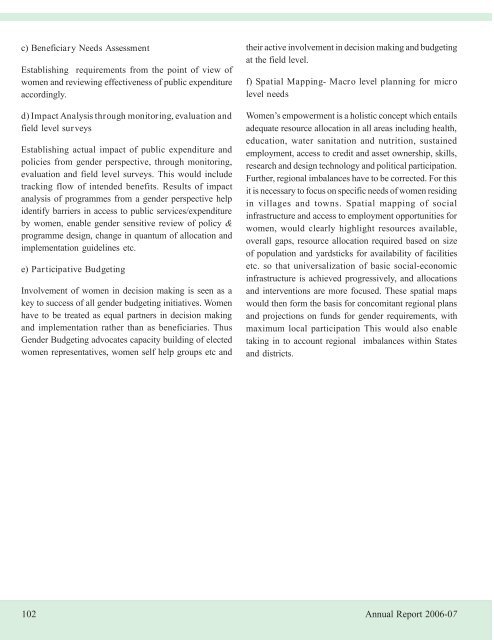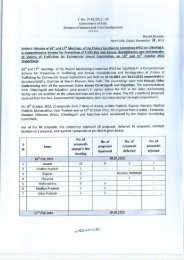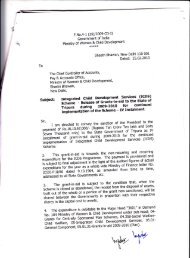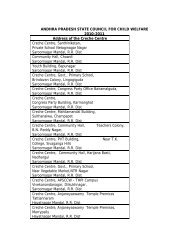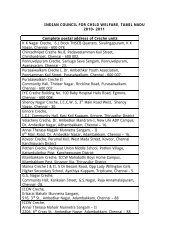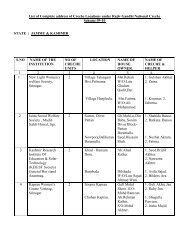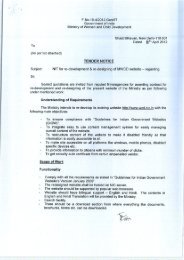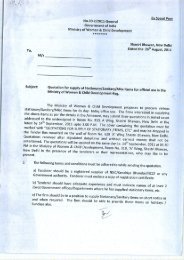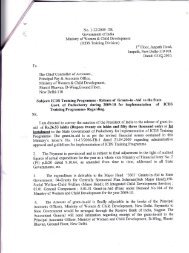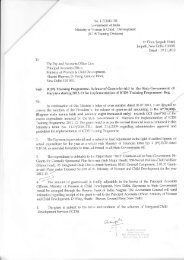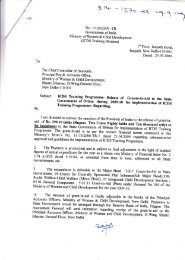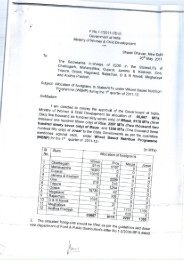COVER HINDI - Ministry of Women and Child Development
COVER HINDI - Ministry of Women and Child Development
COVER HINDI - Ministry of Women and Child Development
- TAGS
- hindi
- ministry
- wcd.nic.in
You also want an ePaper? Increase the reach of your titles
YUMPU automatically turns print PDFs into web optimized ePapers that Google loves.
c) Beneficiary Needs Assessment<br />
Establishing requirements from the point <strong>of</strong> view <strong>of</strong><br />
women <strong>and</strong> reviewing effectiveness <strong>of</strong> public expenditure<br />
accordingly.<br />
d) Impact Analysis through monitoring, evaluation <strong>and</strong><br />
field level surveys<br />
Establishing actual impact <strong>of</strong> public expenditure <strong>and</strong><br />
policies from gender perspective, through monitoring,<br />
evaluation <strong>and</strong> field level surveys. This would include<br />
tracking flow <strong>of</strong> intended benefits. Results <strong>of</strong> impact<br />
analysis <strong>of</strong> programmes from a gender perspective help<br />
identify barriers in access to public services/expenditure<br />
by women, enable gender sensitive review <strong>of</strong> policy &<br />
programme design, change in quantum <strong>of</strong> allocation <strong>and</strong><br />
implementation guidelines etc.<br />
e) Participative Budgeting<br />
Involvement <strong>of</strong> women in decision making is seen as a<br />
key to success <strong>of</strong> all gender budgeting initiatives. <strong>Women</strong><br />
have to be treated as equal partners in decision making<br />
<strong>and</strong> implementation rather than as beneficiaries. Thus<br />
Gender Budgeting advocates capacity building <strong>of</strong> elected<br />
women representatives, women self help groups etc <strong>and</strong><br />
their active involvement in decision making <strong>and</strong> budgeting<br />
at the field level.<br />
f) Spatial Mapping- Macro level planning for micro<br />
level needs<br />
<strong>Women</strong>’s empowerment is a holistic concept which entails<br />
adequate resource allocation in all areas including health,<br />
education, water sanitation <strong>and</strong> nutrition, sustained<br />
employment, access to credit <strong>and</strong> asset ownership, skills,<br />
research <strong>and</strong> design technology <strong>and</strong> political participation.<br />
Further, regional imbalances have to be corrected. For this<br />
it is necessary to focus on specific needs <strong>of</strong> women residing<br />
in villages <strong>and</strong> towns. Spatial mapping <strong>of</strong> social<br />
infrastructure <strong>and</strong> access to employment opportunities for<br />
women, would clearly highlight resources available,<br />
overall gaps, resource allocation required based on size<br />
<strong>of</strong> population <strong>and</strong> yardsticks for availability <strong>of</strong> facilities<br />
etc. so that universalization <strong>of</strong> basic social-economic<br />
infrastructure is achieved progressively, <strong>and</strong> allocations<br />
<strong>and</strong> interventions are more focused. These spatial maps<br />
would then form the basis for concomitant regional plans<br />
<strong>and</strong> projections on funds for gender requirements, with<br />
maximum local participation This would also enable<br />
taking in to account regional imbalances within States<br />
<strong>and</strong> districts.<br />
102 Annual Report 2006-07


